Extracted from a talk entitled “It’s Your Round” by Mark Andrew Pardoe to the Society on 22nd November 2012 about every pub he has managed to find out about in Hitchin.
Mark Andrew Pardoe was the last British Rail archivist and is an expert in various subjects, including Hitchin’s pubs. It would take more space than we have here to describe every pub, as he mentioned about a hundred in his illustrated talk, but here are the ones we managed to jot down during Mark’s dash through the town’s victualling venues!
Market Place:
- the Red Cow, the Red House and the Pelican
- the Artichoke until about 1855, now a deli
- the Rose and Crown, Victorian Gothic style, on the site of the Six Bells – there were six bells in the church tower when it was named
- the Corn Exhange for a while
- the Red Lion until 1852, now Threshers
High Street:
- the Swan from the 16th century until 1884, at the back of the Arcade
- the Cock Hotel with its three gables from around 1563, later Woolworths, then Boots
- the Three Horseshoes, the White Horse and the Black Horse next to each other, now Card Saver.
Brand Street:
-
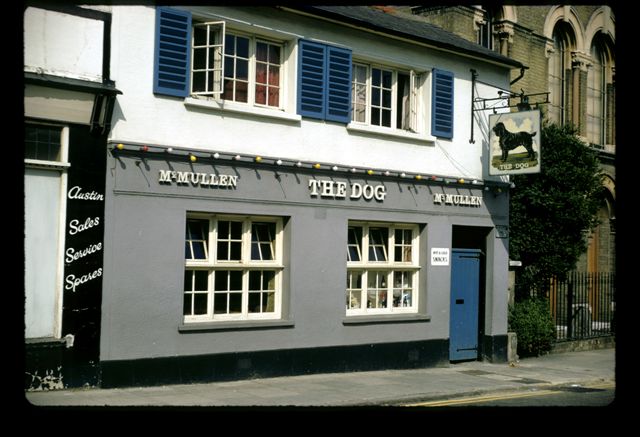
The Dog, Brand Street
the Dog until 1970, then Sainsbury’s
- the Trooper from 1734-1870, where it’s said troops were once billeted, which became Moss’s and is now a phone shop.
Old cattle market:
- the Crown and the White Lion until 1996, now M&S
- the Assizes which opened in 1992 selling Real Ale, became the Sunrunner
End of Bancroft:
- the Adam & Eve from 1672 to 1994, after which it took various names including the Phoenix, and is now the Venue
- the Victoria, Mark’s local, which opened in 1864 but had previously been the Cricketers, the second pub of that name in the town; the Woolpack from 1840 which became the Orchard & Anvil (the forge was oppposite) and closed in 2008.
Nightingale Road:
- the Gloucester Arms, later O’Shea’s and now Molly Malones
- the Nightingale, so called after the Road, which was named after the orchard which was full of nightingales. It was a Fordham’s Brewery pub
- the Railway Junction 1852-1952 became a canteen for Bowman’s Mill and was knocked down in 1962
Walsworth Road starting from the Walsworth end:
-
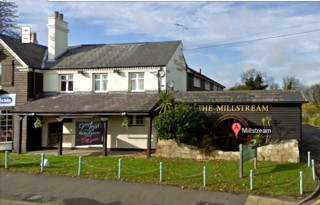
The Millstream
the Mill Stream, which was the Ship from 1866
- the Anchor, opened around 1723
- the Sailor, previously the Sailor Boy from about 1841. The reason for the nautical theme in the area is not known
- the Red Cow from before the 1860s to the end of the 19th century, either the thatched house or the brick one next to it
- the Archer, its precise location not known
- at the Station, the Railway Inn, renamed The Talisman in 1965, then Jeans in the early 1980s, now a Tesco Express and offices
- the Albert, formerly the Earlybird from 1870
- the Radcliffe Arms. Formerly possibly the Rougely Arms from 1631 to 1852 but there is little information about that
Queen Street:
- the Bricklayers Arms
- the King’s Head 1793-1961, formerly the Plough & Dial, but since 1961 it has had fourteen different names! These include the Market Tavern in 1966, and now Shorty’s Sports Bar
Hollow Lane:
- the Robin Hood 1721-1922
- the Peahen
Back to Queen Street:
- the Bricklayers Arms, and another ten or so!
- the Half Moon, once the New Found Inn
Hitchin Hill:
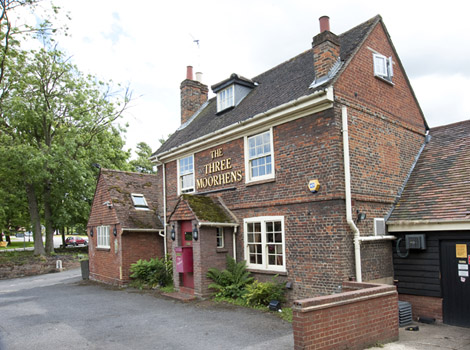
The Three Moorhens
- the Falcon, once the Cross Keys, 18th century to 19th century
- the Three Moorhens from 1742
- the Black Horse, the King’s Head, the King William and one other, all now closed
Stevenage Road:
- the Orange Tree
- the Well from 1844 to 1949, the second oldest brick building in Hertfordshire dating from at least 1612, now Class 2 listed. Formerly the New Found Out
Ninesprings Way:
- the Fountain 1960-1996, at the junction with Oakfield Ave. Replaced by a block of flats, ‘Fountain Court’
Tilehouse Street:
- the Post Boy, closed 1921, now John Leeson’s bookshop
- the Royal Oak, closed 1922
- the Duke of Bedford, opposite the Royal Oak
The Bridge:
- the Plough which became the Plough & Dial, even though the Dial was always a separate pub! Closed 1922
Sun Street:
-
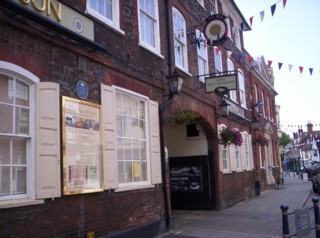
The Sun Hotel, Sun Street
the Sun from 1575, giving the street its name
- the Angel 1450-1956, from which the street was formerly Angel Street

The Angel Vaults, Sun Street
Bucklersbury:
- the Red Lion, formerly the Beehive
- the Red Hart from 1550
- the King’s Head from 1816
- the Anchor in Mill Lane, opened in 1776 and closed in 1779!
- the Wheatsheaf, now Pentangle Design
- the Woodman, 18th century, on the corner with Sun Street
- the Three Tuns
- the Coopers Arms, 1860
- the Queen’s Head, mmid 18th century to mid 19th
- the Bull’s Head, closed around 1916
- the Bell from around 1846
Paynes Park:
- the Swan with Two Necks, closed 1915
- the Waggon & Horses, closed 1982
- the Highlander, 18th century, so named because Highland drovers stopped here with their cattle
Bedford Road area:
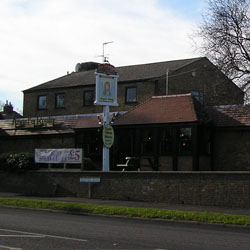
The Angels’ Reply, later The Angels
- the Bricklayers Arms
- the Horse & Jockey, closed 1989
- the Sir John Barleycorn from 1852
- the Bedford Arms from 1860
- the Cricketers, opposite Butts Close, 1828, closed 2009
- the Angel’s Reply, so named because the licensee of the Angel transferred here
The virtual pub crawl ended at Lancaster Avenue. Phew!
Our thanks to Mark for his whirlwind tour of Hitchin’s pubs and their fascinating social history. Many members wondered how the townsfolk of yore ever got any work done, but of course beer was weaker then and water undrinkable – and things did get done.